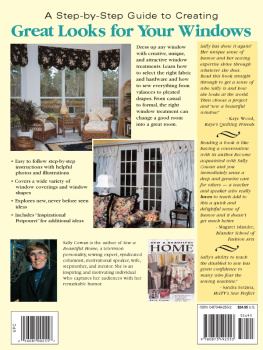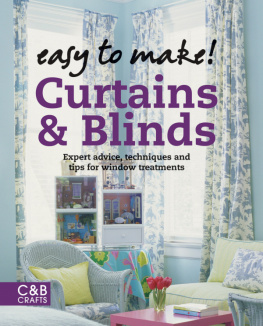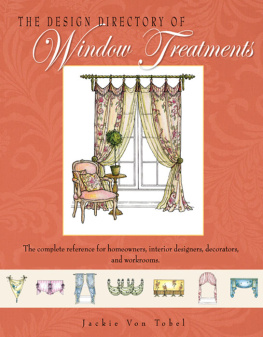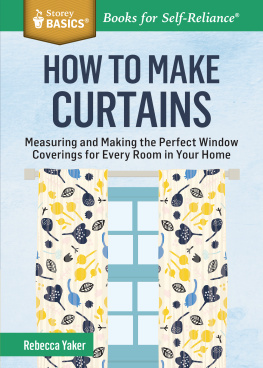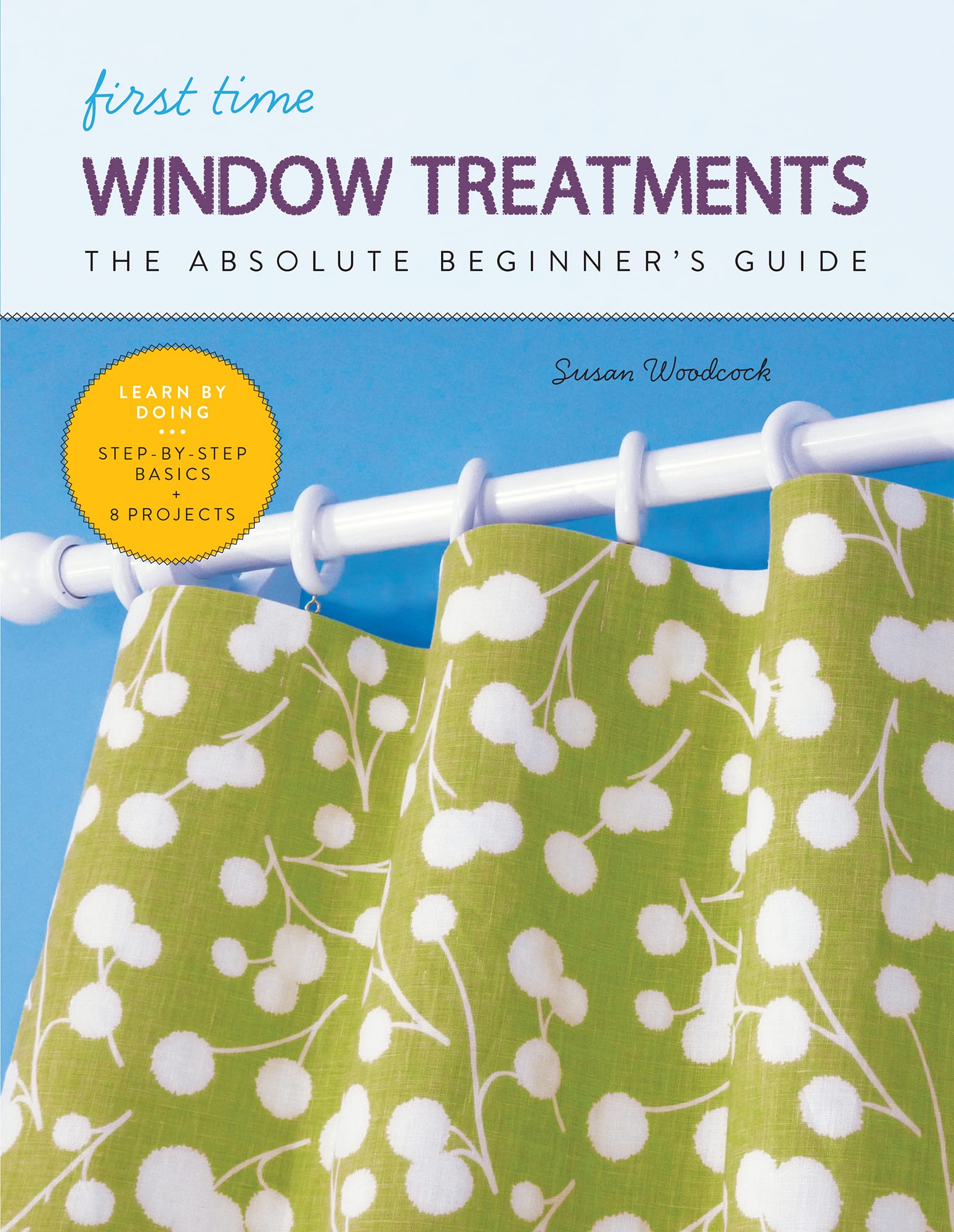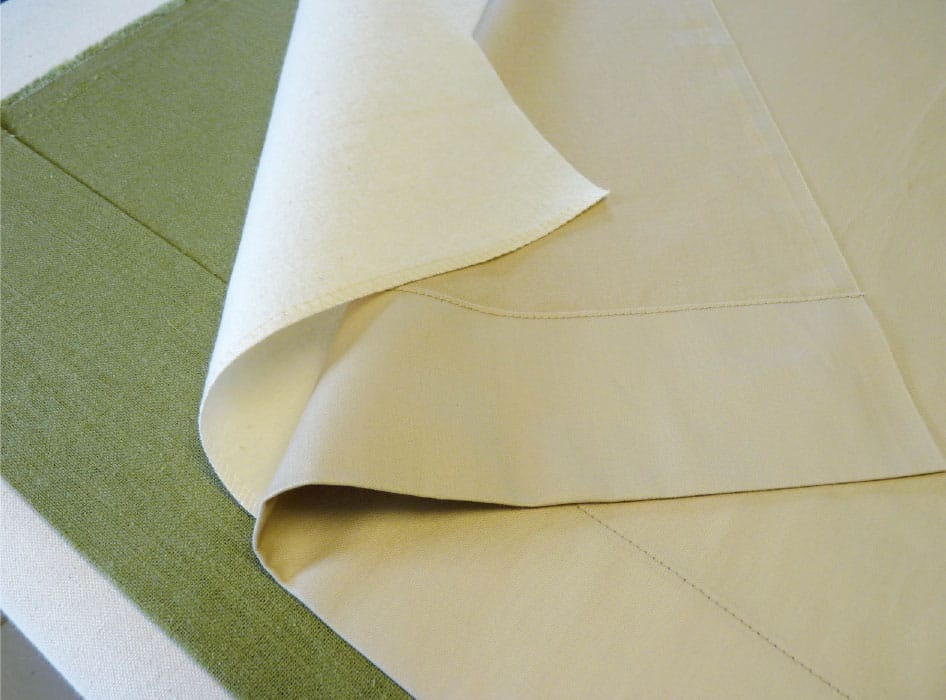Contents
Guide
first time
WINDOW TREATMENTS
THE ABSOLUTE BEGINNERS GUIDE
by Susan Woodcock

introduction
Interior decoration is an important part of every home. Soft furnishings like curtains, bedding, and upholstery can create beautiful rooms filled with pattern, color, and texture. But there is also a practical side. Fabric furnishings can improve your quality of living, making your home inviting, safe, and comfortable.
Creating your own window coverings can be very rewarding. You will feel accomplished and proud of your skills, and save money. That is not to say that making your own window treatments is cheap. The fabric, supplies, and hard-ware that you will need to complete your project can be a big investment. But if you are willing to devote the time and effort to planning and making them properly, your window treatments will last for many, many years. Money well spent!
This book is designed to give you added confidence as you learn basic to intermediate skills. With each new project you will gain experience, and soon you will be able to tackle any type of window treatment.
GETTING STARTED
Making window treatments is different than other types of sewing. You are hanging fabric at a window. Windows are large! It can be intimidating, but most of the sewing techniques are basic and easy to learn. You can start out with basic tools and supplies, and in this section you will learn tips for setting up your workspace to make sewing large projects easier. Lets get started!
setting up a workspace
Before you begin cutting and sewing, you will need to set up a functional workspace. If you do not have a sewing room, create a designated space for working on your project. Because of the size of window treatments, and the amount of fabric you will be handling, its most helpful to have a large, sturdy worktable. In fact, it is perhaps the most important tool for making window treatments!
In a professional workroom you will find large worktables 60 inches (152 cm) wide by 10 to 12 feet (3 to 3.7 m) long. The tops are covered with canvas stretched over an underlayment for pinning and a thin layer of dense batting. This provides a large cutting and ironing surface, and fabrics can be secured by sticking pins into the underlayment.
You can make a temporary worktable with a dining or Ping-Pong table covered in foam interlocking floor tiles and a quilt, secured with tape or ties under the sides and corners. For a more permanent sewing table, cover plywood with ceiling tiles or insulation board for pinning, top with thin batting, and then stretch heavy canvas over the top, stapling it under the edges. You can place this on top of folding tables with nonskid rug pads to prevent slipping, or secure it to shelving units or even sawhorses. This is much better than trying to work on the floor.
Make sure you have adequate lighting and ventilation. If you are working in a garage or basement with concrete floors, use foam tiles or anti-fatigue mats where you will be standing.
Set up sewing machines so there is plenty of room to manipulate large pieces of fabric. Additional folding tables can help hold the weight and keep fabrics off the floor. A functional and comfortable workspace will make sewing window treatments easier and more enjoyable.
A professional workroom is set up with worktables, fabric racks, a variety of machines, and organized tools and supplies. Photo is courtesy of Frances Pusch Fine Sewing for Interiors (www.FrancesPusch.com).
tools and supplies
You can begin sewing window treatments with common, everyday sewing notions and tools. The good news is that you can get started today! As you gain experience and tackle more complex styles you will need to invest in specialty tools and supplies.
An industrial sewing machine is not required, although it certainly is helpful for sewing heavy fabrics. If your machine has a compensating foot or walking foot, you will find that to be very useful.
Review the list to become familiar with common workroom materials, tools, and supplies.
MATERIALS
Blackout: A lining material that has been treated to block all light. Look for a three-pass blackout material for complete light blocking.
Blackout lining
Buckram: Traditionally a woven cotton cloth stiffened with starch (aka crinoline) but modern versions can be made from polyester or heavy paper. Used to add structure in curtain and valance headings for crisp pleats. Buckram is available in different widths and sew-on or iron-on. The most common width is 4 inches (10.2 cm).
Bump cloth: A very heavy, blanket-like interlining commonly used in silk for a luxurious finish.
Dim out: A light-blocking material for lining window treatments. It is often called thermal lining. This material has a suede-like surface that helps diffuse light.
Hook-and-loop tape: Pressure-sensitive tape like Velcro is used to attach window treatments to boards and in other areas where the fabrics need to be removable yet securely fastened.
Interfacing: A woven or nonwoven material for adding body or stabilizing fabrics.
Interlining: Usually flannel but can be any fabric that is sandwiched between the face fabric and the lining.
Interlining
Lining: A cotton, polyester, or cotton and polyester blend fabric used to cover the reverse side of a window treatment. Look for a lining material that is specifically finished for window treatments; they will perform better than other fabrics. The most common colors of lining fabrics are white, ivory, and khaki.
Pleating and shirring tapes: Sew-on tapes with cords used to make curtains and valances. When the cords are pulled, the fabric makes even pleats, tucks, or gathers. These tapes can have one, two, three, or more cords depending on the style.
Welt cord: Also known as piping; a cord that is covered in fabric and used to finish seams. Welt cord can be made of soft fibers, like cotton or polyester, or firm, with cellulose for upholstery or polypropylene for outdoor use. It comes in a wide range of diameters. Micro welt cord is made with cable cord.


